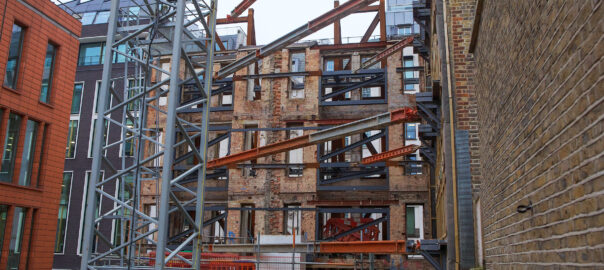25/03/2022
O’Keefe Demolition is nearing completion of a delicate enabling-works contract in the centre of London’s most expensive district.
The company, who were awarded the demolition, façade retention and basement construction project at 13-14 Hanover Street in Mayfair by Frank Capital, has demolished nearly the entire structure, leaving only the original façade supported temporarily on a bespoke structural steel frame.
The project, located in the heart of the West End, spans from Hanover Street and includes 6-7 Pollen Street, a narrow thoroughfare running perpendicular to Hanover Street, posing various challenges in the management of pedestrians and traffic throughout the duration on site.
Installation of 100 tonnes of temporary façade supports to the Hanover Street elevation and the surrounding party walls enabled the wholesale demolition of the six-storey structure behind the façade. Waste arising from the demolition process was removed from site due to the confined location of the site.
Behind the retained façade, O’Keefe has excavated a cavernous 10m two-storey basement and is now in the process of constructing the in-situ concrete retaining walls and basement slabs.
The project will ultimately deliver new Class A1 commercial premises comprising five floors of office space with retail space on the ground floor.
Besides the technical challenge of retaining the building’s original façade, O’Keefe has the additional challenge of demolishing a building with three party walls.
“It’s a very delicate job,” comments O’Keefe’s project manager Kevin Hartigan. “All the neighbouring buildings are fully occupied and one of them is a Michelin-starred restaurant.”
The works have had to be meticulously planned and all noisy operations scheduled so as not to disturb the neighbours.
“We’re talking to them all the time,” explains Kevin. “We let them know when we need to plan noisy work, and they let us know when they need quiet. We work around them.”
Noise, vibration and dust all need to be minimised.
“We have site monitoring equipment set up to take readings all the time. We have a surveyor come in every week and we get a weekly report,” says Kevin. “I also send a weekly report off to our client, plus we have a monthly meeting with the local authority environmental people.”
Traffic is another top priority for the site team, says Kevin: “Good traffic management is essential because this is a very busy location. We’re on several bus routes – all the buses come down here!”
Due to the extra basement level, O’Keefe has had to underpin to a depth of up to 7m along all of the party walls. The retaining wall along Pollen Street was originally specified as a steel sheet-piled structure but O’Keefe modified the design to use contiguous bored concrete piles.
“The original design would have interfered with a mains electric supply running along Pollen Street. The cables would have had to be lifted and moved temporarily to the other side of the street,” explains Kevin.
“Our solution was to install contiguous piles in front of the existing retaining wall, which got us round the problem.”
Logistically, one of the biggest challenges has been to coordinate the works so that O’Keefe could simultaneously carry out underpinning and piling works while demolishing the upper storeys of the old building.
“We also designed and installed all the temporary supporting steelwork for the façade, which is very complex,” says Kevin.
The steel was designed in-house and fabricated by Mareth Fabrications, based in Slough.
By mid-February, O’Keefe had poured the lower basement slab and was beginning to install the reinforced concrete basement walls.
“Next, we’ll be fixing the formwork for the B1 basement slab and then continue up to ground floor level,” says Kevin.
After that, construction of the new building, on top of the basement and behind the original façade, can begin.
ENDS

